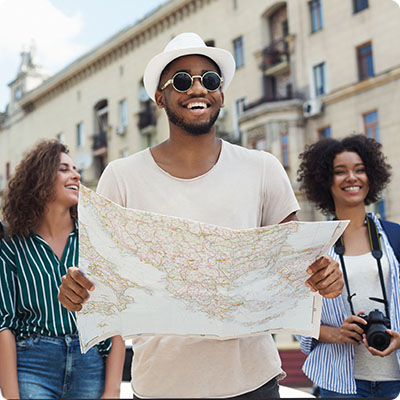
Soccer, THE national sport
Soccer, a religion? This commonplace that one hears when talking about football in Latin America fits perfectly with Uruguay. And every parent dreams of their children following in the footsteps of Enzo Francescoli, the country's idol, who shook the soccer world in the 1980s and 1990s. Imported by English immigrants and initially played by gentlemen, soccer soon became more democratic and Uruguay became a leading nation in the game. In the 1920s, the small country won two Olympic gold medals in 1924 and 1928, before organizing the first World Cup in 1930. A competition won by the Celeste, the nickname of the Uruguayan team, which will win the final against Argentina in the monumental Estadio Centenario of Montevideo, built for the occasion. Before a second world title in 1950 by beating Brazil at home, in its mythical Maracanã stadium in front of ... 173 850 spectators! A national tragedy for the Brazilians, still known as "Maracanazo" ("the shock of Maracanã"). In spite of some other epics, notably the Copa America 1956, 1967, 1987 and 1995 (won by Enzo Francescoli's team), the Celeste will be more discreet on the international scene. Before a strong comeback at the South African World Cup in 2010, where the teammates of Diego Forlan (voted best player of the tournament), Luis Suarez and Edinson Cavani reached the semi-finals, and the victory in the Copa America the following year. In the national championship, the classic and hottest match of the season is the clash between Nacional and Penarol, two historical clubs from Montevideo.
Polo, the other English heritage
As in Argentina, it is a very popular sport in Uruguay. Polo arrived in the Río de la Plata area with English immigrants at the end of the 19th century. David Shennan is said to be the pioneer, having organized the first polo match in 1875 in his Argentine estancia. The clubs and places of play developed gradually in the region, because the large spaces of the estancias were conducive to this sport, as were the horse farms. Two Uruguayan clubs are worth mentioning: the Carrasco Polo Club in Montevideo and the Medellin Polo Club near Punta del Este, between La Barra and José Ignacio, where you can take polo lessons overlooking the sea.
Pato (in France, it is called horse-ball), practiced especially by the gauchos in the pampas, is a derivative of polo with some particularities of basketball.
Horseback riding, the queen activity
There is nothing like estancias to practice horseback riding or to enjoy rides with gauchos, the South American cowboys. The gauchos, who also meet during the big rodeo of the Semana Criolla del Prado in Montevideo in April, still use their companions to lead the cattle in the vast plains of the country. Some areas are more suitable for horseback riding than others: the Cuchilla Grande, in the north of the country, especially near Tacaruembo, and the natural reserves of the Rocha region.
Leisure activities in nature
It is essential to explore the country's rivers, including the River Plate, the River Uruguay and the River Negro. Most of these rivers are navigable and river trips around Mercedes, Fray Bentos, Soriano and Dolores are possible. It is also possible to do rafting in the surroundings of Paysandu.
For a hiking and climbing trip, go to Quebrada de los Cuervos, near Treinta y Tres, to Valle Edén, near Tacuarembó, to Valle del Lunarejo, near Rivera, which contains a rich geological, botanical and zoological heritage. Finally, in the department of Flores, the Gruta del Palacio, a labyrinthine complex, is worth seeing.
Excellent fishing spots
Uruguay is a beautiful fishing destination and three areas are particularly suitable for fishing: the banks of the Río de la Plata, between Colonia and Piriápolis for angling; between Piriápolis and Punta del Este (this would be one of the best places to fish); and finally on the Atlantic coast, in the department of Rocha, up to the Brazilian border. The coastal area( UruguayRiver or Negro River ) can also be considered and allows amateurs to catch superb specimens, either by fly fishing or by casting. The surubí, a kind of giant catfish, and the dorado, a lichen with an impressive size, populate the waters of these rivers. Fishing contests are even organized. Other species include tararira, bagre (another type of catfish), corvina, anchovy, pejerrey (atherina)... To practice, you can contact the fishing clubs of Salto, Paysandú, Fray Bentos, Punta del Este, Montevideo... There you can get information about licenses, equipment rental, etc.
Relaxation and water sports
The country has a superb Atlantic coast with wild beaches and long stretches of golden sand. A coastline not unlike the French Atlantic coast, with its pine forests on wild dunes. Alternately lively and busy, quiet and discreet, wild and preserved, the seaside resorts have many faces. The Uruguayan Riviera has its share of posh villages, José Ignacio in the lead, followed by La Barra and Manantiales, Punta Ballena, which have dethroned the big neighbor Punta del Este. The latter still offers some nice spots, but its American-style concrete center, lined with bars and nightclubs, does not generally appeal to the French. The Rocha coast is more "natural": the riverbanks and the beaches of the coastline have an authentic and exotic face and are worth a visit.
Obviously, it will be possible to practice many water sports, especially around Punta del Este, particularly recommended for scuba diving, and in the department of Rocha. Windsurfers, kitesurfers and surfers can also enjoy great conditions, while many clubs offer motorized water sports such as water skiing, wakeboarding, jet skiing, parasailing and other towed buoys.




















